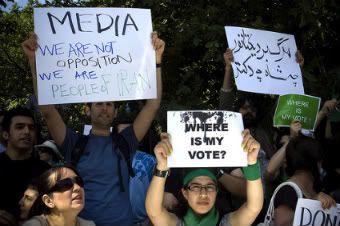Ironically, Silver concluded that, "To properly analyze Iran's election results is probably something best left to Middle East experts, rather than experts on U.S. electoral politics."
Maybe he should check the Tehran Bureau's web site to see people with American sounding names telling Iranians who've just risked their lives to protest election fraud that it was all a waste of their time.
Posted at the Tehran Bureau, Faulty Election Data (or pdf of site)
Mike Thomas says:
June 13, 2009 at 16:55
As much as I’m sure the Iranian elections are bullshit rigged. The mathematical analysis in this post is flawed. For a very neat explanation of why this is the case, visit http://www.fivethirtyeight.com/ where Nate Silver links to this post and explains the problem."
The "problem" is the impertinence of the poster's "neat explanation" and his reference to Silver's flawed and historically vacant critique of a fraud analysis that is just one part of a much larger picture of election fraud in Iran. It is a life and death struggle faced by the Iranian people not an online fantasy game.
"People of Iran"
"Media, we are not opposition, we are people of Iran" reads sign left.
Iranians in Great Britain demonstrate at Iran's Embassy. Image
Why was this particular election fixed in the way that it was?
What were the high stakes that required a blatant cramdown of the Supreme Leader Ali Khamenei's choice, the deranged Ahmadinejad?
The 1979 Iranian Revolution was not monolithic. It consisted of leftist nationalists, represented by students and others, primarily in urban areas, a right wing based on Islamic law, and other distinct factions. Iran's first Supreme Leader, Ayatollah Khomeini, is said to have balanced these constituencies to prevent the domination of one or the other opposed factions. The complex counterbalancing powers are assigned to various groups to perpetuate the ruling Mullahs and while giving the appearance of a degree of political freedom. The Iranian Constitution reflects this goal.
Iran's reformers favor a more open society, openings to the West, and a more capitalist economy. Ahmadinejad's faction has a radical interpretation of Islamic law that's highly restrictive. This restrictiveness includes criminal acts like executing those convicted of homosexual behavior. Ahmadinejad is also pushing a hard for a redistribution of wealth.
Rafsanjani is opposed to this for several reasons. According to Forbes he's one of thee wealthiest men in the world. He wants more openings to the West. In this campaign, he has also been the target of highly personal attacks by Ahmadinejad who accused him of fraud in a presidential debate.
Rafsanjani fired back with an open and very public letter to Supreme Leader Ali Khamenei reminding him that he, not Ahmadinejad, was a true follower of the balance of power initiated by Khomeini. The letter was also a preemptive notice to the current government to avoid stealing the election according to Hossein Bastini, an Iranian foreign policy analyst.
Of note, Rafsanjani is head of both the Expediency Discernment Council and the Assembly of Experts. While both are powerful positions under Iran's Constitution, the Assembly of Experts has fundamental power. It selects Iran's maximum leader, the supreme leader, and it has the power to remove that leader if it determines the he has strayed from Islamic principles.
Structuring the 2005 elections to take legislative power from Iran's reform faction was the first step in moving on the reformers and their most powerful ally, Hashemi Rafsanjani. Stealing the 2009 Presidential election was the second of four steps to secure total control of Iran. The allegiance of the armed forces and the Supreme leader are the final two acts, it would appear, in Ahmadinejad's drama.
(Note: You can view every article as one long page if you sign up as an Advocate Member, or higher).





